#On people and places that aren't originally arab or muslim
Text
Me, watching sonic and the secret rings: :)
Me, coming to the part of king solomon: >:(
Seriously, king solomon- or by his native name "Sh'lomo"- a hebrew jewish king of a jewish kingdoms ruling over the kingdom of israel is portrayed in the arabian nights, in an arabic stories with arabic ornaments and clothes and cultural signs. The worldwide claim over jewish characters(people) and stories is just so frustrating. Its ok that he is written in the christian bible and the quran but people and companies that adapt these characters and stories need to do it right and acknowledge the JEWISH part and culture in a JEWISH king, king solomon physically CAN'T have muslim-arabic culture bc it didn't exist yet nor did it was in ancient israel
#sonic the hedgehog#sonic and the secret rings#king solomon#israel#jumbler#am israel hai#jewish#jews#Jewish culture#There was no arabic culture in ancient israel#Stop inflicting arabic and muslim culture#On people and places that aren't originally arab or muslim#ישראל#עם הנצח#ישראבלר#עם ישראל חי#its just frustrating#GIVE ME A NORMAL AND ACCURATE JEWISH REPRESENTATION FFS#Its not too much to ask
48 notes
·
View notes
Note
Please make more stories about Algerians taking over France, and French people having to be slaves and drinking their spit, becoming their wives, kissing and cuddling.
Your writing is incredible! It gets me so horny all the time. It’s truly a talent.


10 / 03/ 2024
ASK ANSWERED : EURABIA STORIES
Thanks for the question! I've wrote countless stories about Arabian/Muslim Domination. I wrote many stories featuring Arab men when the master's origin isn't specified, but most of the time they are supposed to be Algerians, or Turkish. Since i can only put 10 links, you'll find some stories abut what you asked in your public message.
I used to be excited by Arabian's domination but I'm more into the Black New World Order
It does not mean some Arabian men aren't hot, but they are divided between the ones who consider themselves French and wants to be part of the French society, and there is other who considers their mission is to enslaves French white people and there is even French white people who agree with it.

The Islamization of France is such a danger that there is many books about this topic 😱


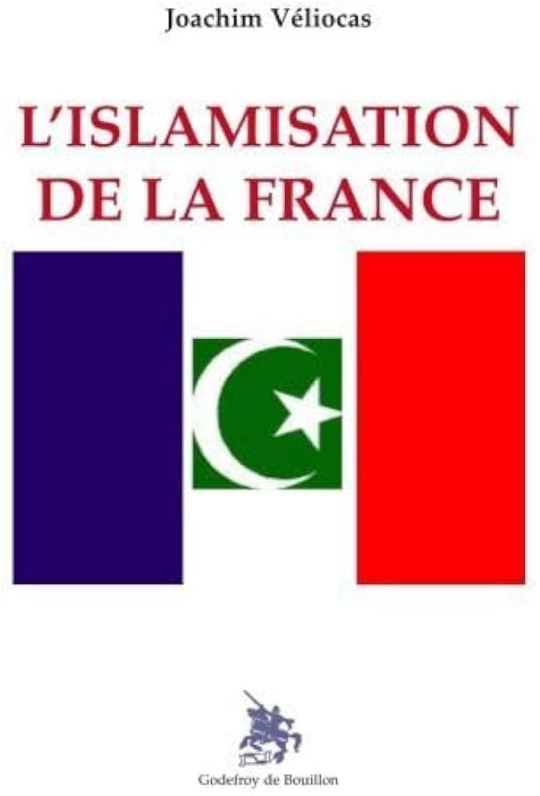
These drawings shows Muslim men as danger, because currently France is endangered by Muslims supremacists and the French white people who supports them

These drawings in French shows politicians serving Arabian men, licking their shoes to shows they prefer worshipping migrants and Muslim men rather than being patriotics.



If you are searching for stories about Eurabia and France being ruled by Muslims, this is the one you must read. It's one of my longest and favorite stories. 😉 It's a story where I imagined President Emmanuel Macron being in love with his former bodyguard, Alexandre Benalla, who have Maroccan's parents. In this long and detailed story, with a lot of sadism and humiliation, i imagined how Muslims people would take power in France :
A story where whitebois from the French Football Team, especially Antoine Griezman, are enslaved by Arabian and Blacks teammates. Eurabia is described because it is supposed to takes place when Alexandre Benalla have taken power over France
A French white family enslaved by Arab men
Another story where an Algerian family enslaves a French white family, and the boy is married to the Muslim man at the end :
A French white gay couple enslaved by an Algerian /Muslim family. One of the French whitebois is married and feminized :
I include this story which isn't about a French man but about an English boy. However, since he is feminized and forced to serve Muslim men, it's related to what you enjoy. I really appreciated writing this story, because Anjem Choudhary is hot for a Muslim man 😁
A French whiteboy in high school enslaved by his dominant Muslim schoolmates :
Another story about a French boy enslaved since France is ruled by Arabians / Muslims
A question I've been asked about Muslim men, with links of stories about them 😀
An Algerian gay couple served by an old French white man when they are in Algeria :
I wrote many others stories about Muslim domination, but i hope you'll like them 😊 Please don't hesitate to like, reblog and comment them if you appreciated my stories
@eurogirlsdestruction @maitresrebeux @muslimdomination4europe @rebeuarab @muslimfeet @arabiandomination-blog @muslimsfuckeuropeanwomen @eurabiansubject @whiteslavetoblack @arabslavemasters @arabicadmirer @tidodore2 @rainykpoptravelcreator @lovefanfiction01 @gayhopefullove @leftprogrammingroadtripdean
17 notes
·
View notes
Note
“Are you trying to say that the Palestinians aren't the original people of Judea?” what a funny way to phrase that. what ethnic group does anon think “Judea” might be named after?
This is, I'm afraid, just as stupid an ask as the original anon. Again, the Jews are not the original inhabitants of Palestine/Judea/the southwestern Fertile Crescent! In fact, according to Jewish mythology, the Jewish claim to the land rests on the divinely sanctioned massacre of its previous inhabitants, which is a very bad justification by modern standards. Indeed, the original name of the land, according to those narratives, was Canaan--after, y'know, the Canaanites. Archeologically speaking, the ancient Hebrews are a subgroup that emerges gradually out of the other Canaanite/Northwest Semitic cultures in the region--it's clear that that's not actually what happened--but these people are not culturally, genetically, or religiously identical to modern Ashkenazi, Sephardi, and Mizrahi Jews. And having an ancient ancestral link to a distant place does not in fact give you property rights over that place, or else the United States would have a right to conquer Britain, partition the country, and expel the English.
The people in southwest Asia actually haven't suffered any major population ruptures in the last 2,000 years from what I understand; what has changed enormously in that time is culture and religion--Hellenization from the conquests of Alexander, Romanization and Christianization under the Roman Empire, and Islamization and Arabization under the Muslim conquests. But genealogically the Palestinians are pretty much continuous with the ancient Hebrews. Language and religion change a lot more easily than actual people do.
And this is why treating ethnicity--which is an identity category not the same as but entangled with all these historically contingent markers like language and religion--as the primary unit of moral concerns is a bad idea. You do not get to expel people from their homes because they do not practice the ways of their ancient ancestors!
And again, let me remind you--the original inhabitants of "Judea" (which has had many names) were a group of Neanderthals whose language has been forgotten. If we're going to use names as signifiers of the original inhabitants, we should probably rename the country something in Pleistocenese, along with most of Europe and western Asia.
#it really is impossible to have a normal conversation in the context of israel-palestine discourse#which is why i do not want to discuss that political context specifically#i just want to push back against this kind of reflexive shallow nonsense#that sees expression in many other contexts as well
46 notes
·
View notes
Text
Chess Blog Day #38 - Chess and Its Family
Although there still remains some debate on whether chess originated in India or Persia, most historians believe chess to have originated in India.
The common ancestor of chess-like games would then be Chaturanga.
"Chaturanga" literally means "four divisions". The four divisions were infantry, cavalry, elephants and chariotry. These would later become the modern pawn, knight, bishop and rook.
Chaturanga was played on an 8x8 board but this board wasn't checkered like a chessboard.
Chaturanga was probably the earliest game to have two things that chess has that other board games like Go don't: Different pieces with different powers, and a single piece that the game centres around trapping (a "king").
Chaturanga was then introduced to Persia (modern Iran) and became Chatrang, which was eventually given the Arabic name Shatranj.
In Chaturanga the king could be captured. Persian players must have decided that this was no fun because at some point in the 700s the rules of Shatranj were changed so that you couldn't put yourself in check and had to move out of it.
Shatranj had the king, knight and rook equivalents move the way they do to this day; but the pawn, queen and bishop equivalents were much less powerful.
This didn't entirely solve the problem of instantly losing games via a silly mistake though, as any online blitz player will attest. Oh well.
Players also had to announce "shāh" (meaning "king", the origin of the modern "check") when they attacked their opponent's king. And of course they also had to declare "Shāh Māt!" ("the king is dead!"), the origin of the modern checkmate.
Later on they started to engrave half of the squares and the iconic checkerboard came into play.
Shatranj sets are typically more minimalist than Chaturanga sets, likely because of the Muslim ban on idolatry that we mentioned yesterday.
Here's a Chaturanga set (left) compared to a Shatranj set.

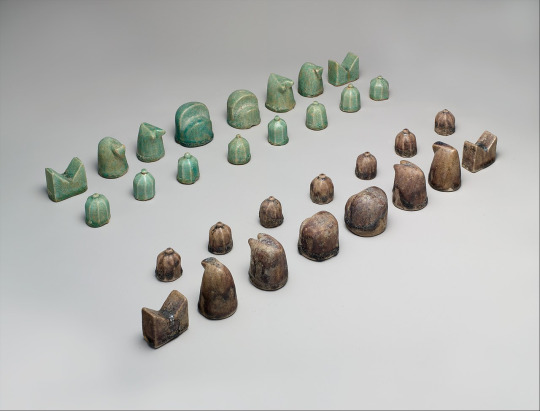
Before we continue down the descent of chess, we need to take a look at its cousins.
Chinese chess, xiangqi, is thought to be derived from Chaturanga. There are some niche historical theories that it was the other way around, but these aren't well supported. It has the two properties of a chess-like game that we mentioned before - a "king" and pieces with different moves. Xiangqi doesn't have squares though. Pieces are placed on intersections like in Go.

Shogi, or Japanese chess, is also thought to be derived from Chaturanga and may have been invented in India. Some historians even believe that it was originally played with 3D Chaturanga pieces and not the 2D set that it is today. Shogi has the interesting property of being able to use your opponent's pieces after you capture them, reflected in the western variant of bughouse chess.
One theory is that this rule was added at a time in Japanese history when there were a lot of mercenary fighters switching loyalties.

Makruk, or Thai chess, is another Chaturanga derivative. It's actually much more similar to Chaturanga than Chinese or Japanese chess, and is probably the closest thing to Chaturanga still played today aside from chess itself.

In fact Chaturanga derivatives spread so far east that they reached what is now the USA, as chess-like pieces have been found belonging to the Tlingit people of Alaska.
Back to chess.
Eventually Shatranj was introduced to Europe and became associated with violence, revelry and gambling (I know). The historical cultural impact of chess could be its own blog post.
Eventually chess became more prestigious and associated with knights and royalty, who played with ornate pieces. Christian cultures didn't have the same issues with idolatry at that point in history and began making the sort of elaborate sets we saw yesterday.
At this point the rules hadn't really changed from Shatranj.
There were a couple of early European rule changes though. Pawns were allowed to move two squares on their first move and en passant was added to balance this out. King and queens could jump on their first move (queens were still weak and king jumping eventually became castling).
People also experimented with the idea of setting up the pieces behind the pawns however they wanted, although this never caught on.
Then around 1500 AD the Spanish came along and decided that chess was just too slow. They decided that bishops and queens should have the move ability that they do today.
This was initially called "Mad Queen Chess" or "Chess with the madwoman".
This update spread like wildfire though because clearly everyone found it led to much more action.
Finally in the 1800s the modern rule around stalemate was added, castling was standardised, and all later rule changes like threefold repetition were more technical in nature.
We talked a little bit about the rule changes over history, but some of them are quite interesting so it's worth looking into them in more detail.
Tomorrow: The rules of chess's ancestors.
#chess#board game#history#chaturanga#shatranj#chatrang#xiangqi#shogi#makruk#japanese chess#chinese chess#thai chess#tlingit#mad queen chess#en passant
2 notes
·
View notes
Text
The "Historical" Disney Costume Rant that Nobody Asked For
To fairly preface this, I am not an expert on Arabian/Middle Eastern culture, pre- or post-Islam. I'm not a fashion historian as in having a degree, only a vaguely passing knowledge and ability to stay up at all hours of the day and night to research obscure topics such as this. However, I am not dismissing or invalidating the feelings of Arabs, Middle Eastern people, or Muslims in regards to Jasmine from 'Aladdin.' I AGREE with them that Jasmine's clothing is neither accurate to the "period" and culture of the Middle East (generally speaking) or appropriate. Jasmine's costume design is viewed through the lens of orientalism, exoticism, and stereotypes of Middle Eastern and Arabian culture.
HOWEVER...
I take issues with this design:
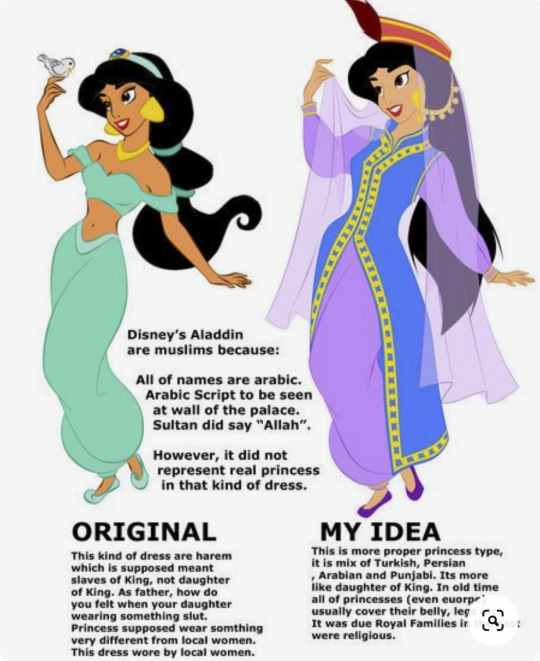
Original Pinterest Post here
Right off the bat, could we not have slut-shamming, please? For five minutes? I understand that 16 year old Jasmine probably shouldn't be exposing that much shoulder and midriff, but that's not a call for slut-shaming. Could we not?
From what I can find, not even slaves or concubines wore the kind of things Jasmine does in any period of the Middle East or Arabia. Her father wouldn't be called "king," he'd either be Shah or Sultan, but that's just a tiny nitpick for me. The meat of the issue for me is the "information" provided between the two figures.
There's not concrete evidence that the characters of Aladdin are Muslims just because they use Arabic names, though some of those names aren't, in fact, Arabic.
Jasmine = Persian (Indo-Iranian dating back to the 5th century BC)
Iago = Spanish
Rajah = Sanskrit
Arabic wasn't invented in the 7th AD. The language is a branch of the Semitic language and emerged around the first century BC. The Arabic word for "God", Allah, is older than Islam. Evidence has shown that "Allah" has been around since at least the 5th century BC. Which makes it entirely possible that use of the word Allah and Arabic names does not definitely indicate that Aladdin takes place after 6th-7th century AD Middle East. Furthermore, I have a suspicion that it takes place much, much earlier than that. Being as old as I am, I have some canon that younger Disney fans might not know. Back in the day (late 1990's and early 2000's), Disney produced cartoon series for Aladdin and Hercules around the same time. Aladdin and Hercules CANONICALLY meet in a crossover episode of their series in an episode of Hercules, "Hercules and the Arabian Nights," which aired in February 10, 1999.
Source 1
Source 2
Since Hercules and Aladdin have canonically met in the same universe, it can only mean that Aladdin takes place in, at least, the Bronze or Iron Age alongside Ancient Greece.

Ergo, the characters in Aladdin do not necessarily represent Middle Eastern or Arabian Muslims from the 7th century AD and beyond. If we were going to set Aladdin in a more "historically accurate," Agrahba would take place in either a multicultural pagan Middle East or one ruled mostly by Zoroastrians, which is equally misunderstood and underappreciated by the West as Islam.
But I have digressed far enough. It kind of bothers me that Jasmine is repainted to be so much "fairer" looking. Not all Arabs or Middle Eastern groups have dark skin, but making her paler to make her appear "better" is...certainly a choice. Furthermore, Arabian and Middle Eastern costumes vary by region, but all are beautiful and colorful.
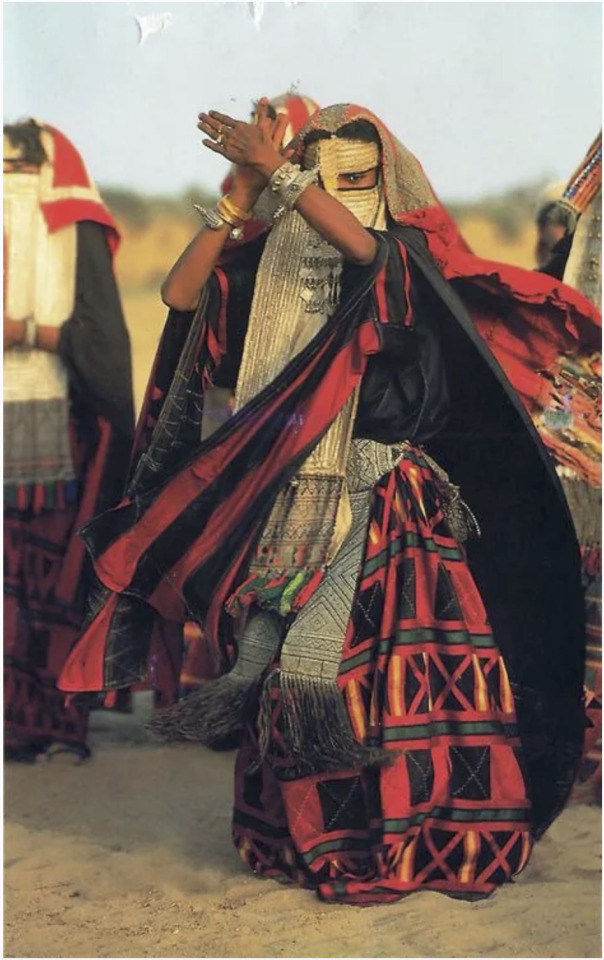
Source

Source
Turkish is not the same thing as "Arabic." For example:
And if we consider pre-Islamic fashion, Jasmine probably would dress more like this:
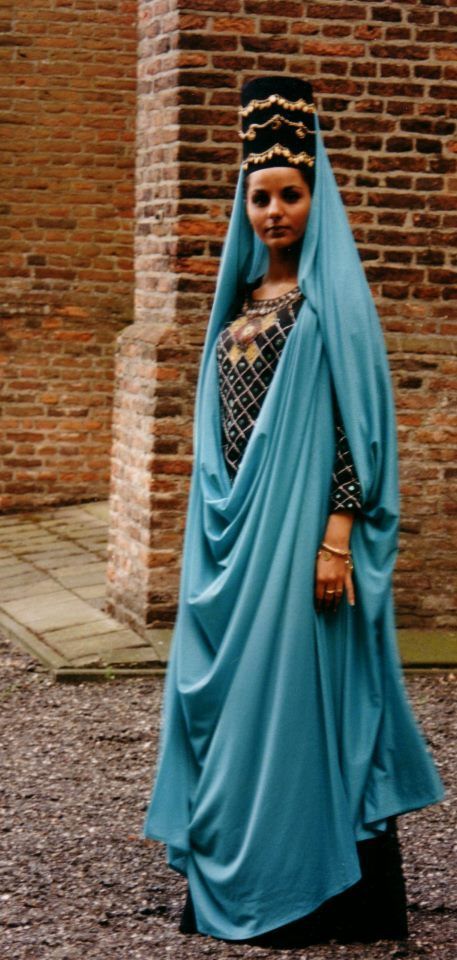
Supposedly, this is a recreation of Parthian dress (Parthian Empire, 247 BC-224 AD).
Combining different cultures such as Turkish, Arabic, Punjabi, and Persian together does the historic costuming of Arabic, Persian, and the Middle East in general a great disservice. The Middle East is not a monolith of culture just because currently it is majority practicing Muslims. Punjab is on the other side of the Indus Valley, and it's Indo-Aryan (not THAT Aryan) in origin, not Arabic. Curious why it's included beyond the fact that many Punjabi today are Muslim.
I'm really not trying to bash the artist here. They have the right idea, but I think with a little more research creating a "new" Jasmine would be far more interesting than pulling from various cultures around the Middle East and Islamic cultures from different regions and slap them together. Thank you for hearing me needlessly ramble coming to my TED Talk.
5 notes
·
View notes
Note
Anyone who's pagan or polthiest is a pagan/polytheist, even if they're bigots(depending on their religious system of course). As an exmuslim myself i see both sides, orthodox muslims straight up being antisemitic and (some consider people who believe in multiple deities(hindus in particular as unclean and impure) as it's in their beliefs specifically, sects also hate other sects, and exmuslims and non muslims being extremely islamophobic towards muslims, cases I've seen myself. The death penalty is still there for those who leave Islam in some countries, homosexuality is still illegal in many Islamic countries, women and genderqueer and trans folks and children are still fucked over, but only in those countries exmuslims exmuslims (like myself) and (some) muslims care, non muslims and non exmuslims don't, that's why they don't talk about it, they shove it under the rug of "respecting cultures and beliefs" as if those who are hurt aren't human beings. Criticism of religion is important if we want to evolve as a society, but only muslims and exmulims should be allowed to even criticize islam. What's a person that's never been a Muslim doing reading about the faith and criticizing it?? It's not right and its not the same. I've never been a Christian or Jew so i never talk or criticize them (unlike many many exmuslims, its still wrong), especially that one of them is closed. Muslims and nonmuslims alike also love using islamophobia as a shield against valid religious criticism its ridiculous. If people accept ex Christians and their criticism of Christianity and see both ways, the same should be for exmuslims.some Exmuslims should also better themselves and have humanity and sympathy in their hearts towards muslims and spiritual/religious people. New atheists suck too. We also can't forget what happened to arabic polytheists at the time of islam, imagine living peacefully as a pagan and then someone comes along and says there is only one true deity and that whom you believe in is false, or the (potential fact that many practises in Islam are most likely of pagan origins) which is like a big f u to those poor folks, imagine having your religious idols destroyed and not being able to do anything about it, perhaps if one puts themselves in their shoes they'd know what it feels like. People always talk about(ooh Christianity banned paganism/polytheism its so evil😭) but never about Islam and it actions and consequences. Mabye They could never understand. (P.s: I'm sorry this isn't directed at you in particular but at all of the issues above and the excuses given by people, i know you'd understand, you're not an idiot nor a bigot.).
I'm going to go out on a limb here. I've been around a few places in the world, and I've been around people.
No religion is free from faults. If you believe people of Pagan/polytheistic religions have never used their religions and gods for personal gain, for greed, for power, and for control, if you think no blood has ever been spilled in the names of Pagan gods/polytheistic faiths, then you've got some learning to do.
The problem has never been the religions. Religions on their own are just religions. The problem is not whether we say God or Allah. Is not whether one god is worshipped or a hundred. Is not whether there's a church or a temple.
3 notes
·
View notes
Note
For DND AMA: Do you have suggestions for how to deal with bigoted source materials, and adapting things to promote inclusion as a whole more broadly as a DM? I'm working with some,,,questionable source material (Dragon Age) in its handling of indigenous, BIPOC, and muslim coded cultures within their canon in my own DND campaign I'm working on.
ooh yeah. i'm not familiar with dragon age lore, but i have reworked a lot of wizards of the coast stuff into my dnd game, so some of the same principles probably apply. (although if you're straight-up using an established setting, it might be harder. a lot of what i've done is made easier by the fact that the setting is a creation of my imagination and so there's no expectation for things to be a certain way.)
i take a lot of inspiration from real-world cultures and i don't think there's anything wrong with doing that - but the way WOTC, for instance, does it but then uniformly makes a culture inherently evil or violent or whatever, that's problematic. so, there just aren't any cultures in my dnd game that are wholly bad or corrupt or evil, for starters. adding a lot of nuance and examples of good/bad deeds done by all kinds of people, and in general just complicating everything lol, is a place to start.
this is something i've been working on during the genie arc of my current 5e campaign. i've read a lot about the origins of djinn and ifrit and ghuls and other arab myths and folklore, so i can work those things into the lore of my world in a way that feels more 3D. i've made it clear in-game that there are a LOT of differing individuals, opinions, and worldviews in every group. and when i do use real-world influences, i try my best to do so in a way that's nuanced and intentional. and also, importantly, i throw most of the WOTC lore right into the trashcan, lmao. seeing where they've done it wrong is a jumping off point for me to try to do it better.
i don't know if this is helpful, so i'll attempt to give you a tl;dr here lol: know where the source material did a bad, bad job. throw most of it in the trash. do your research. add nuance and complexity.
7 notes
·
View notes